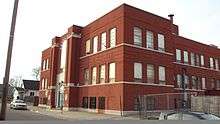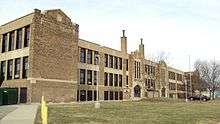Hamtramck Public Schools

Hamtramck Public Schools (HPS) is a public school district based in the city of Hamtramck, Michigan (USA) in Greater Detroit.
The district has the Schools of Choice program, which allows non-district students to enroll in district schools.[1]
As of 2011 the official graduation rate is 62%. In 2011 the United Way for Southeastern Michigan arranged a program, funded by a $27.1 million General Motors Foundation grant, intended to improve the graduation rate.[2]
History

After Hamtramck became a municipality in 1922, every member of the Hamtramck Board of Education was a Pole and most students of the school system were Polish Catholics. In 1925, of the school district's 7,526 students, about 5,400 were ethnic Polish. Half of the ethnic Polish students were non-US citizens. By the mid-1920s, of the school-attending children in Hamtramck 66% attended public schools.[3] The public schools typically had 45 students per classroom while the parochial schools in Hamtramck had 70 students per classroom.[4] In the early 1920s the annual growth rate of Hamtramck Public Schools buildings was 27% while non-public schools had an annual growth rate of 6% in that period.[3] In the 1920s the Polish language became a part of the curriculum at Hamtramck Public Schools. In 1925 655 students attended Hamtramck High School. JoEllen McNergney Vinyard, author of For Faith and Fortune: The Education of Catholic Immigrants in Detroit, 1805-1925, wrote that Hamtramck High had "substantially more students than were in all of Detroit's Polish Catholic high schools combined."[4]
In the 1920s Hamtramck families often sent their children to public school for Kindergarten due to convenience, then moved their children to parochial schools during the periods with the most important religious instruction. Therefore, the age group 7 to 12 had the largest Catholic school enrollment. After the critical period ended, many students returned to public school. In 1925 the public schools had 1,467 students of ages 14–15 while the non-public schools had 217 students aged 14 and 15.[4]
In a period in the 20th Century, 8% of HPS teachers were Polish.[5]

In February 2003 the district had an annual budget of $35 million and had 3,800 students.[6]
In April 2003, George Ward, a former assistant prosecutor with the government of Wayne County, Michigan, investigated the spending practices of the district. The investigation described how the district spent $80,003 and took 18 months to build the Veterans Memorial Park picnic pavilion. It originally had been purchased as a picnic shelter kit at a home-improvement chain store for $2,000.[7]
In 2003, a five-year plan for the improvement of the district was revealed. The Detroit News, that year, described the district as "troubled".[8]
In June 2004 the Detroit News called the financial situation of the district "troubled".[9] On Thursday June 24, 2004, the Michigan Department of Education sent a team of academic and financial experts to conduct reviews of the school system. The Detroit News stated that under Michigan law, the first step for the state to take in order to take over the operations of a school district would be to conduct a financial review.[9] Martin Ackley, who served as the spokesperson for Tom Watkins, the State Superintendent of Education, argued that the move was not a state takeover but rather something he referred to as "state assistance."[9]
In 2005 the openings of charter schools had reduced the enrollment at the Hamtramck district schools. That year, Paul Stamatakis, the superintendent, stated that a committee was researching how viable it would be for the school district to provide classes for the Arabic and Bengali languages. This was an effort to retain its Arab and Muslim students.[10] In 2005 the district had a funding-per-pupil of $6,700 per year per, the lowest in the state. This compares to the funding-per-pupil of $7,100 per year of Detroit Public Schools. M. Kay Siblani of The Arab American News wrote that "Declining enrollment, rising costs and inadequate state funding are straining the system almost beyond repair."[11]
In 2008 officials from the district announced that they planned to offer vocational programs such as building trades, culinary arts, and computer training and to expand adult education.[12]
Demographics
As of the 2013-2014 school year the district had 3,078 students from 23 countries of origin. Fewer than 45% of students have English as a primary language.[13] As of 2013, the most common non-English languages spoken in the district are Bengali, Arabic, Bosnian, Polish and Albanian.[14] 45% of the students are Arabic-speaking.[13]
In the 2008-2009 school year the district had 2,873 K-12 students, 69 preschool students and 281 adult/community education students from 23 countries of origin. 85% of the students were enrolled in free or reduced lunch. The main primary languages of students were English, Bengali (21.8%), Arabic (18.8%), Bosnian (7.5%), Polish (2.4%) and Albanian (1.5%).[15]
As of 2001, 900 registered students who spoke Bengali and Urdu attended Hamtramck Public Schools.[16]
Sally Howell, author of "Competing for Muslims: New Strategies for Urban Renewal in Detroit", wrote that "It is difficult to find educators in Hamtramck who speak positively about the challenges this diversity creates. Yet the public schools, overtaxed by non-English-language communities and riddled with ethnic tension among teens, are nonetheless eager to prevent the loss of their Muslim students to charter schools, or to Highland Park."[17]
School uniforms
Beginning on September 8, 2009, students in grades 1-8 in the district will be required to wear school uniforms.[18] Beginning in 2010, high school students also had to wear school uniforms.[19]
Schools
High School
- Grades 9-12
- Hamtramck High School
- Horizon High School (alternative)
K-8
- Kosciuzsko Middle School/Dickinson West
- It was named after Thaddeus Kosciuszko. It has about 400 students. It became a middle school in the 1970s; previously it was an elementary school.[21]
- Kosciuzsko Middle School/Dickinson West
Elementary Schools
- Grades 1-6
- Dickinson East Elementary School
- Grades K-8
- Holbrook Elementary School
- Holbrook is Hamtramck's oldest school. It was named after the family of Dewitt C. Holbrook. The Hamtramck Planning Commission dedicated a plot of land towards constructing a school on June 26, 1891. By 1896 a frame schoolhouse had opened. In 1896 the school administration had three rooms added to the brick school building. During that year 350 students attended the school. The number of students steadily increased from 1901 to 1903. An extension opened in 1913. In the 1920s a fire destroyed the school's third floor. The school never had the floor rebuilt. The school was remodeled in 1929. The school website states "Improvements in the buildings heating system and lighting have occurred, but for the most part, the building remains the same today as it did in 1929."[22]
- Holbrook Elementary School
- Pre-School-1
- Early Childhood Center
Defunct Schools
- Carpenter Elementary School - This school has been razed.
- Copernicus Elementary/Middle School - Present-day location of Hamtramck High School.
- (Old) Hamtramck High School - Hamtramck used to be housed in an older building along Wyandotte & Hewitt streets, until it moved to Copernicus in 1970—this school has since been razed.
- Pilsudski Elementary School - This school has been razed.
- Pulaski Elementary School - This school has been razed.
See also
References
- Feinstein, Otto. Ethnic Communities of Greater Detroit. Monteith College, Wayne State University, 1970.
- Howell, Sally. "Competing for Muslims: New Strategies for Urban Renewal in Detroit". Located in: Shryock, Andrew (editor). Islamophobia/Islamophilia: Beyond the Politics of Enemy and Friend. Indiana University Press, June 30, 2010. ISBN 0253004543, 9780253004543.
- Vinyard, JoEllen McNergney. For Faith and Fortune: The Education of Catholic Immigrants in Detroit, 1805-1925. University of Illinois Press, January 1, 1998. ISBN 025206707X, 9780252067075.
Notes
- ↑ "2009 - 2010 Schools of Choice Registration." Hamtramck Public Schools. Retrieved on June 18, 2009.
- ↑ Sercombe, Charles. "Hamtramck Schools get a big boost." The Hamtramck Review. April 15, 2011. Retrieved on April 18, 2011.
- 1 2 Vinyard, p. 182.
- 1 2 3 Vinyard, p. 183.
- ↑ Feinstein, p. 238. "The proportion of teachers of Polish descent is not so great in Detroit as in Hamtramck, where they constitute more than 8 per cent of the whole number. Northeastern High School in Detroit has the largest number of its staff, the principal, the librarian, and two of the teachers being Poles born in Europe."
- ↑ "Charter school planned for Hamtramck." The Detroit News. February 26, 2003. Retrieved on September 8, 2013. Document ID: det15308115. "The Hamtramck Public Schools enroll 3800 students and have an annual budget of $35 million. Competition from the planned public school "will hurt the school[...]"
- ↑ "Hamtramck schools' spending investigated." The Detroit News. April 16, 2003. Retrieved on September 8, 2013. Document ID: det16196414.
- ↑ "Board works on improving schools." The Detroit News. June 18, 2003. Retrieved on September 8, 2013. Document ID: det16620923.
- 1 2 3 "District's finances get state scrutiny." The Detroit News. June 25, 2004. Retrieved on September 8, 2013. Document ID det19206990.
- ↑ Cecil, Angel. "HIGHLAND PARK SCHOOLS SEEK MORE ARAB, MUSLIM STUDENTS." Detroit Free Press. January 28, 2005. News p. B2. Retrieved on September 8, 2013. byline says: "HAMTRAMCK, DETROIT INTEND TO KEEP THEM" - article text says: "The Hamtramck and Detroit public school districts, which have seen charter schools decimate their enrollments, are studying ways to retain students. Because they're going to have Arabic classes. " and "Paul Stamatakis, superintendent of Hamtramck Public Schools, said a committee is researching the viability of offering classes in Arabic and Bengali."
- ↑ Siblani, M. Kay. "Hamtramck looks to community for school aid." (Archive) The Arab American News. May 21, 2005. Retrieved on September 13, 2013. Available at Highbeam Research.
- ↑ Cecil, Angel and Zlati Meyer. "WAYNE COUNTY NEWS BRIEFS." Detroit Free Press. March 11, 2008. News p. B2. Retrieved on September 8, 2013. "Hamtramck Public Schools officials plan to expand adult education and offer vocational programs such as computer training, culinary arts and building trades."
- 1 2 "Educational Plan for English Language Learners Manual Title III Plan 2013/2014." (ELL Manual, Archive) Hamtramck Public Schools. p. 3/34. Retrieved on November 8, 2013.
- ↑ "Educational Plan for English Language Learners Manual Title III Plan 2013/2014." (ELL Manual, Archive) Hamtramck Public Schools. p. 30 (32/34). Retrieved on November 8, 2013.
- ↑ "Hamtramck Horizon Fall 2009." (Archive) Hamtramck Public Schools. p. 2. Retrieved on November 5, 2012. "The Hamtramck Public School students represent twenty-three countries of origin. Next to English, the top five primary languages are Bengali (21.8%); Arabic (18.8%); Bosnian (7.5%); Polish (2.4%) and Albanian, Shqip, (1.5%). Eleven other languages are considered primary languages by the rest of the student body."
- ↑ Tysh, George. "Little Bengal." (Archive) Metro Times. June 5, 2002. Retrieved on September 8, 2013.
- ↑ Howell, p. 219.
- ↑ "Uniforms." Hamtramck Public Schools. Retrieved on June 18, 2009.
- ↑ "Dress Code (2010-2011)." Hamtramck Public Schools. November 3, 2010. Retrieved on April 17, 2011.
- ↑ "Map." Hamtramck Public Schools. Retrieved on June 18, 2009.
- ↑ "Kosciuszko Middle School." Hamtramck Public Schools. Retrieved on November 26, 2011.
- ↑ "Holbrook Elementary." Hamtramck Public Schools. Retrieved on November 27, 2011.
External links
| Wikimedia Commons has media related to Hamtramck Public Schools. |
